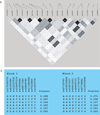Gene-by-environment effect of house dust mite on purinergic receptor P2Y12 (P2RY12) and lung function in children with asthma
- PMID: 22010907
- PMCID: PMC3353543
- DOI: 10.1111/j.1365-2222.2011.03874.x
Gene-by-environment effect of house dust mite on purinergic receptor P2Y12 (P2RY12) and lung function in children with asthma
Abstract
Background: Distinct receptors likely exist for leukotriene (LT)E(4), a potent mediator of airway inflammation. Purinergic receptor P2Y12 is needed for LTE(4)-induced airways inflammation, and P2Y12 antagonism attenuates house dust mite-induced pulmonary eosinophilia in mice. Although experimental data support a role for P2Y12 in airway inflammation, its role in human asthma has never been studied.
Objective: To test for association between variants in the P2Y12 gene (P2RY12) and lung function in human subjects with asthma, and to examine for gene-by-environment interaction with house dust mite exposure.
Methods: Nineteen single nucleotide polymorphisms (SNPs) in P2RY12 were genotyped in 422 children with asthma and their parents (n = 1266). Using family based methods, we tested for associations between these SNPs and five lung function measures. We performed haplotype association analyses and tested for gene-by-environment interactions using house dust mite exposure. We used the false discovery rate to account for multiple comparisons.
Results: Five SNPs in P2RY12 were associated with multiple lung function measures (P-values 0.006–0.025). Haplotypes in P2RY12 were also associated with lung function (P-values 0.0055–0.046). House dust mite exposure modulated associations between P2RY12 and lung function, with minor allele homozygotes exposed to house dust mite demonstrating worse lung function than those unexposed (significant interaction P-values 0.0028–0.040).
Conclusions and clinical relevance: The P2RY12 variants were associated with lung function in a large family-based asthma cohort. House dust mite exposure caused significant gene-by-environment effects. Our findings add the first human evidence to experimental data supporting a role for P2Y12 in lung function. P2Y12 could represent a novel target for asthma treatment.
Conflict of interest statement
The authors have no conflicts of interest to disclose.
Figures


Comment in
-
The LTE(4) -P2Y12 pathway in asthma.Clin Exp Allergy. 2012 Feb;42(2):176-9. doi: 10.1111/j.1365-2222.2011.03926.x. Clin Exp Allergy. 2012. PMID: 22288512 No abstract available.
Similar articles
-
Genome-wide interaction study of dust mite allergen on lung function in children with asthma.J Allergy Clin Immunol. 2017 Oct;140(4):996-1003.e7. doi: 10.1016/j.jaci.2016.12.967. Epub 2017 Feb 4. J Allergy Clin Immunol. 2017. PMID: 28167095 Free PMC article.
-
The LTE(4) -P2Y12 pathway in asthma.Clin Exp Allergy. 2012 Feb;42(2):176-9. doi: 10.1111/j.1365-2222.2011.03926.x. Clin Exp Allergy. 2012. PMID: 22288512 No abstract available.
-
Local receptor-interacting protein kinase 2 inhibition mitigates house dust mite-induced asthma.Eur Respir J. 2024 Oct 3;64(4):2302288. doi: 10.1183/13993003.02288-2023. Print 2024 Oct. Eur Respir J. 2024. PMID: 39117431
-
Allergy to house dust mites and asthma.P R Health Sci J. 2004 Mar;23(1):47-57. P R Health Sci J. 2004. PMID: 15125219 Review.
-
SURFACTANT PROTEIN A: AN INNATE IMMUNE MODULATOR AND THERAPEUTIC IN ASTHMA.Trans Am Clin Climatol Assoc. 2024;134:94-112. Trans Am Clin Climatol Assoc. 2024. PMID: 39135597 Free PMC article. Review.
Cited by
-
Inhibiting P2Y12 receptor relieves LPS-induced inflammation and endothelial dysfunction.Immun Inflamm Dis. 2022 Oct;10(10):e697. doi: 10.1002/iid3.697. Immun Inflamm Dis. 2022. PMID: 36169256 Free PMC article.
-
Prasugrel metabolites inhibit neutrophil functions.J Pharmacol Exp Ther. 2013 Jan;344(1):231-43. doi: 10.1124/jpet.112.195883. Epub 2012 Oct 24. J Pharmacol Exp Ther. 2013. PMID: 23097214 Free PMC article.
-
Gene-Environment Interactions-What Can These Tell Us about the Relationship between Asthma and Allergy?Front Pediatr. 2017 May 22;5:118. doi: 10.3389/fped.2017.00118. eCollection 2017. Front Pediatr. 2017. PMID: 28589116 Free PMC article. Review.
-
LPS-induced systemic inflammation is more severe in P2Y12 null mice.J Leukoc Biol. 2014 Feb;95(2):313-23. doi: 10.1189/jlb.1012518. Epub 2013 Oct 18. J Leukoc Biol. 2014. PMID: 24142066 Free PMC article.
-
Genome-wide expression profiles identify potential targets for gene-environment interactions in asthma severity.J Allergy Clin Immunol. 2015 Oct;136(4):885-92.e2. doi: 10.1016/j.jaci.2015.02.035. Epub 2015 Apr 24. J Allergy Clin Immunol. 2015. PMID: 25913104 Free PMC article.
References
-
- Lee TH, Woszczek G, Farooque SP. Leukotriene E4: perspective on the forgotten mediator. J Allergy Clin Immunol. 2009;124:417–421. - PubMed
-
- Arm JP, O'Hickey SP, Hawksworth RJ, et al. Asthmatic airways have a disproportionate hyperresponsiveness to LTE4, as compared with normal airways, but not to LTC4, LTD4, methacholine, and histamine. Am Rev Respir Dis. 1990;142:1112–1118. - PubMed
Publication types
MeSH terms
Substances
Grants and funding
- P01 HL083069/HL/NHLBI NIH HHS/United States
- P01HL083069/HL/NHLBI NIH HHS/United States
- T32HL007427/HL/NHLBI NIH HHS/United States
- R01 AI078908/AI/NIAID NIH HHS/United States
- K12 HL089990/HL/NHLBI NIH HHS/United States
- R37 AI052353/AI/NIAID NIH HHS/United States
- R01 AI052353/AI/NIAID NIH HHS/United States
- T32 HL007427/HL/NHLBI NIH HHS/United States
- K08 AI093538/AI/NIAID NIH HHS/United States
- U19 AI095219/AI/NIAID NIH HHS/United States
- U01 HL075419/HL/NHLBI NIH HHS/United States
- U01HL075419/HL/NHLBI NIH HHS/United States
- R0152353/PHS HHS/United States
- R01AI078908/AI/NIAID NIH HHS/United States
- K12HL089990/HL/NHLBI NIH HHS/United States

